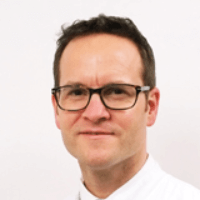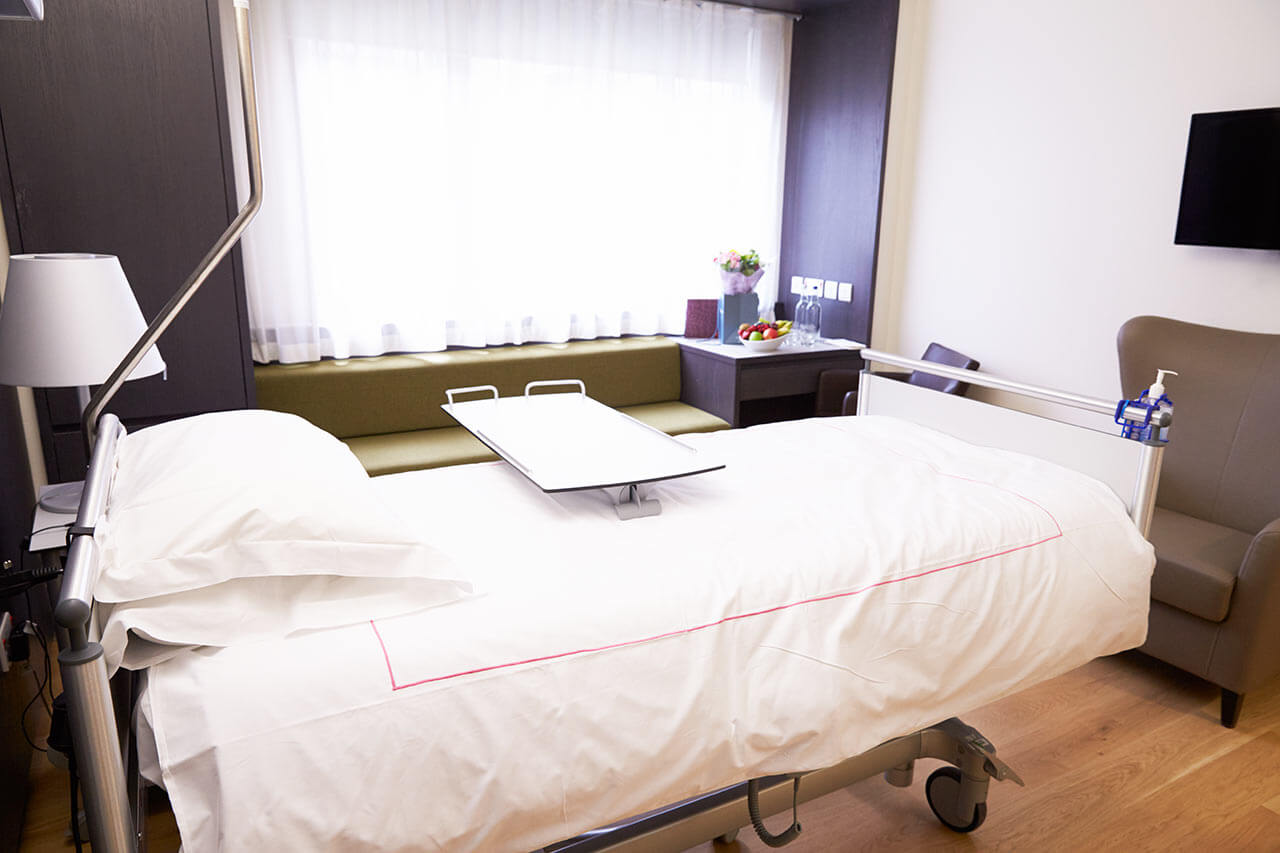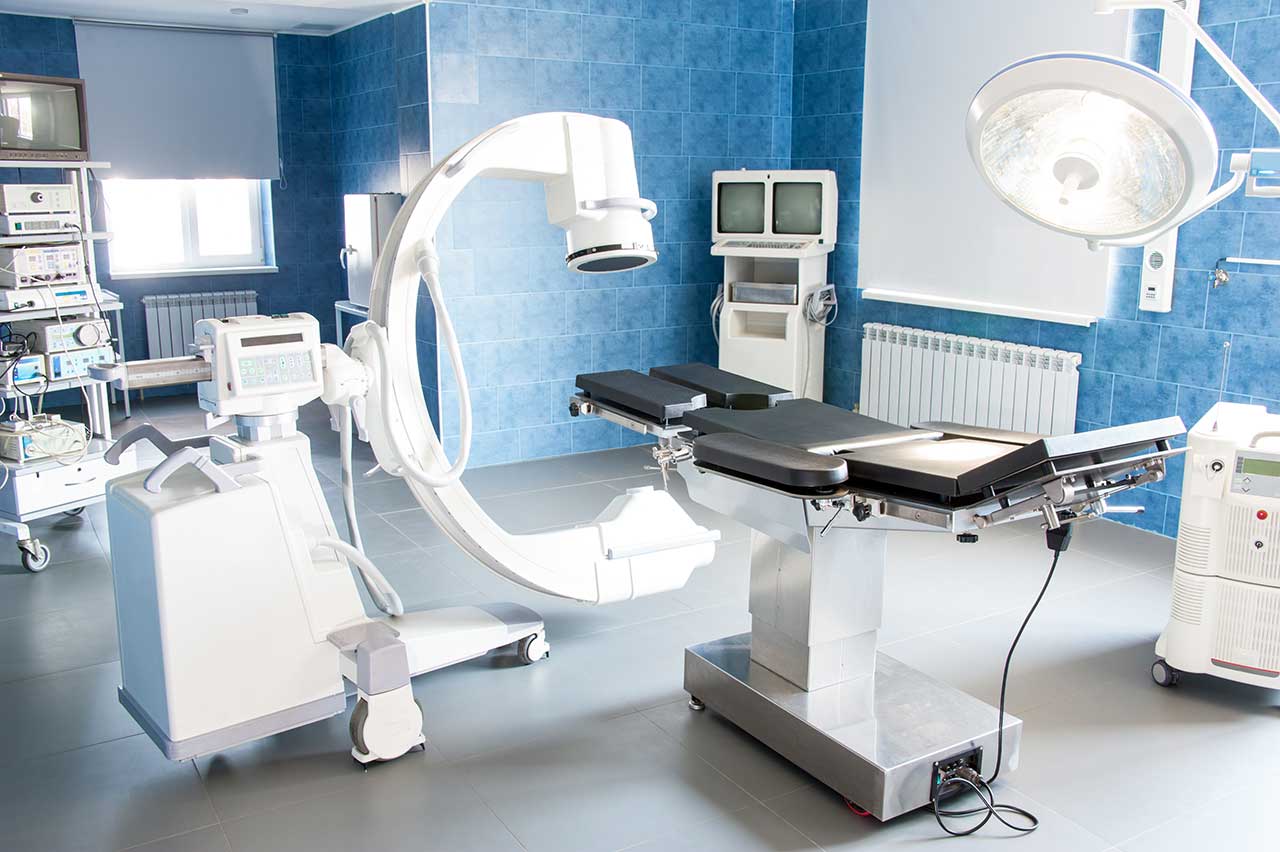
The program includes:
- Initial presentation in the clinic
- clinical history taking
- review of medical records
- physical examination
- X-ray examination of the knee
- MRI scan of the knee (if indicated1200 €)
- nursing services
- consultation of related specialists
- consultation of the chief physician and all leading experts
- development of individual treatment plan
Required documents
- Medical records
- X-ray examination, MRI/CT scan (if available)
Service
You may also book:
 BookingHealth Price from:
BookingHealth Price from:
About the department
The Department of Adult and Pediatric Orthopedics, Foot Surgery at the St. Vinzenz Hospital for Orthopedics Duesseldorf offers the widest range of modern medical services to patients suffering from musculoskeletal diseases. The department specializes in knee and hip replacement surgery, including revision interventions to replace previously implanted artificial joints. The department has the status of a certified Maximum Care Endoprosthetics Center (endoCert), which means adherence to the requirements of European professional societies for carrying out procedures of this kind, a high level of safety and treatment efficiency. It is worth noting that the department uses the innovative ROSA® robotic system for performing knee replacement surgery. A special Rapid Recovery Program is used for the rapid recovery of mobility after joint surgery, which allows the patients to quickly return to their usual life. An integral part of the department's clinical practice is also the treatment of foot diseases and deformities in adults and children. The medical facility has been operating for more than 50 years, and therefore it provides patients with the highest quality medical care and easily copes even with highly severe pathologies.
The department is headed by Prof. Dr. med. Christoph Schnurr. The specialist has an impressive clinical experience and an excellent international reputation in the treatment of orthopedic diseases.
The department performs more than 1,000 knee and hip replacement surgeries annually. The experience and unique skills of the surgeons, a large number of operations, high-quality implants and innovative techniques, as well as the use of accurate navigation systems contribute to optimal surgical results. Prior to the prescription of joint replacement surgery, the department's doctors devote a sufficient amount of time to personal communication with the patient, studying his medical history and complaints. During the initial visit, the attending physician carries out a thorough clinical examination, after which the patient undergoes an X-ray examination. As a rule, the X-ray examination is sufficient to confirm or exclude the diagnosis of arthrosis – pathology is characterized by gradual destruction of the joint due to degenerative and dystrophic changes in the tissues. Computed tomography and magnetic resonance imaging are rarely required. If the pathology is detected at the early stages, the department's specialists use only conservative treatment methods: intake of painkillers, physiotherapeutic procedures, intra-articular injection therapy, and other manipulations. This allows the doctors to relieve pain and delay surgery, but do not help the patient to completely get rid of arthrosis. In the advanced stages of pathology with severe symptoms, including severe pain syndrome and limited mobility, the only effective method of treatment and prevention of disability is joint replacement surgery.
If the patient requires the surgical intervention, an important stage in preparation for it is the choice of the optimal type of prosthesis. The department's medical team uses only high-quality endoprostheses from leading world manufacturers, which are distinguished by the maximum service life. It is possible to implant a custom-made endoprosthesis, if required. At the preparatory stage, the doctor also tells the patient in detail about the upcoming surgical intervention, the method of its implementation and postoperative measures to restore mobility. The department performs knee and hip replacement surgery using minimally invasive techniques, involving only a few small skin incisions instead of traumatic opening of the joint cavity. Doctors use special navigation systems for the most accurate positioning of the prosthesis. When performing knee joint surgery, doctors also often use the ROSA® robotic system, which allows the doctors to place the prosthesis with millimeter precision based on the patient's anatomy. Even before the operation, the device records the anatomical characteristics of the knee joint using special sensors, up to the dynamic measurement of the tension of the ligaments during movements. Thanks to this, the robotic system performs high-precision calculations, which allow the surgeon to place the prosthesis in such a way that the patient has no complications in the future and regains maximum mobility.
An advantage for the department's patients is the successful application of a special postoperative Rapid Recovery Program aimed at ensuring that the patient begins to move freely as soon as possible and return to his usual lifestyle. The program includes a comprehensive preparation of the patient for the surgical intervention, as well as his rapid mobilization with the help of intensive physiotherapeutic procedures and pain management. After the operation, the department's doctors strongly recommend the patients to undergo professional rehabilitation (a course of 2-3 weeks) to consolidate the results of the intervention.
The team of the department's doctors also provides effective treatment of foot diseases in adults and children. The department successfully performs conservative treatment and surgical repair of hallux valgus, hallux rigidus, hammer and claw toes, metatarsalgia, tarsal arthrosis, ankle arthrosis, flat feet, Achilles tendon rupture, heel spur, and other pathologies. Conservative methods are considered as the first-line therapy: pharmacotherapy, physiotherapeutic procedures, special complexes of therapeutic exercises, wearing orthopedic shoes and many others. If the pathology has reached an advanced stage and the above-mentioned methods do not give a satisfactory result, the question of surgical repair is raised. In most cases, the department's surgeons resort to low-traumatic and microsurgical techniques, after which the process of restoring the patient's mobility is much faster and easier. The decision on the advisability of a particular treatment method is made exclusively on an individual basis, according to the data of preliminary diagnostics.
The most common foot deformity in children is the planovalgus foot deformity and the department's doctors successfully perform its correction. The pathological condition quite often does not cause pain and problems with the child's mobility, but if the child experiences discomfort when walking or running, competent medical care is required. First of all, the department's doctors recommend patients wearing orthopedic shoes, special therapeutic exercises and physiotherapy procedures. In most cases, these techniques can ensure good results, and surgery (subtalar arthroereisis) is performed only in the most complex clinical cases.
The department's range of diagnostic and therapeutic options includes:
- Diagnostics
- Laboratory tests
- X-ray (classical and digital)
- Computed tomography
- Magnetic resonance imaging
- Treatment
- Hip and knee replacement surgery of all levels of complexity (operations in case of degeneration, damage, fracture of the prosthesis, etc.), including the use of the ROSA® robotic system and navigation systems for precise positioning of the artificial joint
- Foot surgery in adults
- Hallux valgus
- Hallux rigidus
- Hammer and claw toes
- Metatarsalgia
- Tarsal arthrosis
- Ankle arthrosis
- Flat feet
- Achilles tendon rupture
- Heel spur
- Foot surgery in children
- Planovalgus foot deformity (conservative and surgical treatment methods)
- Other diagnostic and therapeutic services
Curriculum vitae
University Education and Professional Career
- Study of Medicine at the Universities of Bonn, Perugia (Italy) and Pittsburgh (USA).
- Assistant Physician, Hospital Augustinerin Cologne.
- Research Fellow in the Department of Orthopedics and Traumatology at the University Hospital Cologne.
- Managing Senior Physician, LVR Clinic for Orthopedics Viersen.
- Since 01.11.2013 Head Physician of the Department of Adult and Pediatric Orthopedics, Foot Surgery at the St. Vinzenz Hospital for Orthopedics Duesseldorf.
- Since 17.12.2018 Extraordinary Professor, University of Cologne.
- Invited Examiner of the Medical Association of the State of North Rhine-Westphalia, Orthopedics and Traumatology, Special Orthopedic Surgery.
Research and Teaching Career
- Chairman of AGiTEC (Working Group on Intraoperative Imaging and Technology Integration), Working Group of the German Society for Orthopaedics and Trauma (DGOU).
- Reviewer of numerous journals:
- Clinical Orthopedics and related Research.
- The Knee.
- Orthopedics.
- Zeitschrift für Orthopädie und Unfallchirurgie.
- Author of topical publications with a particular focus on joint replacement surgery and computer-assisted surgical techniques.
- 2012 Habilitation, University of Cologne. Subject: "Computer navigation in knee and hip replacement surgery: fundamentals, application, innovation".
- Course of lectures at the University of Cologne and the University of Duesseldorf.
Memberships in Professional Societies
- Working Group for Intraoperative Imaging and Technology Integration (AGiTEC).
- German Society for Orthopaedics and Trauma (DGOU).
- Association of Leading Orthopedists and Traumatologists (VLOU).
- German Association for the Foot and Ankle (DAF).
- International Society of Orthopaedic Surgery and Traumatology (SICOT).
- Working Group on Joint Replacement Surgery (AE).
Photo of the doctor: (c) St. Vinzenz-Krankenhaus
About hospital
The St. Vinzenz Hospital for Orthopedics Duesseldorf is a modern medical facility with a long tradition. The hospital provides high-quality medical care based on the use of the very latest and the most effective treatment methods. The priority area of specialization is the treatment of orthopedic diseases. The hospital operates under Catholic patronage, therefore, long traditions and Christian values are honored here – patients are treated with special care, understanding and compassion. The hospital has 322 beds. It provides treatment to more than 39,000 inpatients and outpatients every year. The medical facility is deservedly proud of its prestige in the European medical arena and unique clinical experience accumulated over many years of hard work for the benefit of patients.
The hospital provides patients with comprehensive medical services in three areas: orthopedics, pain management and gastroenterology, including minimally invasive surgical treatment of gastrointestinal diseases. Of particular interest in the field of orthopedics is the performance of joint replacement surgery within the certified EndoCert Maximum Care Endoprosthetics Center. The doctors working at the hospital always strive to keep up with the times and offer patients the best therapeutic methods available in modern medicine.
The main value for every employee of the hospital is the patient's health, but at the same time, the specialists of the medical facility are convinced that their task is to make the patient feel as comfortable as possible, as well as to surround him with care and attention.
Photo: (с) depositphotos
Accommodation in hospital
Patients rooms
The patients of the St. Vinzenz Hospital for Orthopedics Duesseldorf live in comfortable rooms with light colors and modern design. Each patient room is equipped with an ensuite bathroom with a shower and a toilet. The furnishings of a standard patient room include an automatically adjustable bed, a bedside table for personal belongings, a telephone, and a TV set. The enhanced-comfort rooms are also available for the patients.
Meals and Menus
The patients of the hospital are offered three balanced meals a day: buffet breakfast, hearty lunch and light dinner. The patients are also provided with an individual menu, if clinically indicated.
Further details
Standard rooms include:
Religion
Religious services are available upon request.
Accompanying person
Your accompanying person may stay with you in your patient room or at the hotel of your choice during the inpatient program.
Hotel
You may stay at the hotel of your choice during the outpatient program. Our managers will support you in selecting the best option.




